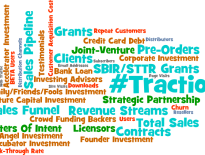
A far too frequently overheard conversation in the startup community goes something like this:
“Apparently neither Instagram nor Snapchat had paying customers while receiving both seed and series A funding?! I couldn’t believe it. Investors, advisors, and incubators these days are constantly trumpeting that a monetization model (or at least an anticipated revenue trajectory) is critical to a business plan. Without one, no investor will give you the time of day. But…apparently they will? Can high user-acquisition volume alone (assuming the team is strong too) still draw heavy funding? How?? I know traction can speak volumes, but still…really?”
Perhaps, just perhaps, we’re being mislead or misguided as to what traction means.
Lean Startup has really done a number on entrepreneurship. Worse, frankly as that’s not really to blame, as tech has perpetuated the world and innovation and entrepreneurship have left Silicon Valley for your neighbor’s garage, investors have naturally been unable to keep pace. Think about it, what happens if the money doesn’t have experience with what you’re doing? Do you think someone who found wealth in real estate naturally takes risk funding Oil & Gas speculation? Granted, that gap is not their fault.
But both factors, investor sophistication and the impact of methodologies to find success in entrepreneurship, are realities which have led to you, to too many people, hearing that you have to have customers.
- New movies (film)
- Residential home building
- Commercial construction
- Medicine
- R&D
- Video game development
- Banks (yes investors), don’t understand what you do nor really care, but you have to deliver an immediate return
- Angel investors, SHOULD know intimately what you do and have the means and desire to pay it forward, seeking a very long term return.
- Venture Capital investors, SHOULD know your industry but not necessarily your niche and they’re obligated (in a sense) to deliver returns for LPs so their time table is a little more risk averse than Angels; but they know the industry and market, so they can make greater investments for relatively lesser returns.
- Private Equity investors find validation through partners, corporations, and the like. They know the space but not necessarily intimately because they have the means to move companies to later stages, putting multiple millions of dollars into companies to get modest but sizeable returns.
 As tech has perpetuated the world and innovation and entrepreneurship have left Silicon Valley for your neighbor’s garage, investors have naturally been unable to keep pace.
As tech has perpetuated the world and innovation and entrepreneurship have left Silicon Valley for your neighbor’s garage, investors have naturally been unable to keep pace.
What is traction?? Why are other industries so well funded without customers? Traction actually means a great many things as it is really nothing more than evidence of opportunity. Lean Startup did a number on us by trying to simplify the path to a degree of success by saying that Customer Validation was paramount. In some cases, it is, but when thrust into a world that hasn’t spent the last 30 years working with tech, when thrust in to a world where the investors have no idea how the tech works, how it scales, how it makes money and so forth, EVERYONE took that too heart and heard Customer Validation = Having Customers and Having Customers means getting funded.
That may well be one of the biggest frauds unintentionally perpetuated and yet significantly consequential in innovation.
As a result, now incubators, investors, and advisors, ignorant of any other way, are constantly telling entrepreneurs they have to have revenue to get funding. But think back to the original role of those investor types… revenue means you get capital from banks (or later stage VCs). Banks. And really, why would you go anywhere else for early funding??? Banks have the lowest cost of capital as an entrepreneur when you consider that you need not give up any equity in your business to get a loan. Of course, that presumes you can get one but how can you not when you have revenue??
So here we are, chasing Angels and VCs and failing to find or communicate any other traction than customer (because that’s what we’re hearing they want) and they, generally not knowing how to see any other form of traction anyway, look at the headway you have with customers and think eh…. I’ll just wait on the sidelines since I don’t understand it anyway and when they get MORE customers, I’ll write a check.
And our venture capital economy collapses. When you have revenue, you can service debt, pay back loans, and more. Revenue alone doesn’t meet the needs of investors and thus investor returns will continue to suffer as long as we focus alone on customers.
How do we break this?
First, entrepreneurs have to appreciate once again that Marketing is not advertising or lead gen. Founders have to stop believing that customers are all that matter; funding marketing only when there is an ROI to acquire a customer.
Famed economist Peter Drucker once put, decades ago, I’m paraphrasing, that “only Innovation and Marketing create value in business, everything else is a cost, and Marketing is the distinguishing of the two.” I assure you, he wasn’t talking about the marketers who get you customers and leads.
If innovation is the creation, marketing is the intelligence. I don’t mean that to sound like I’m saying innovation (or innovators) is ignorant; I mean intelligence in the sense of data, information, and answers. MARKETing is the practice of the Market whereas innovation is the practice of the innov… (sorry, attempting and not funding an amusing play on words there), let’s call it engineering and invention which are the engines of inventions.
Engineered inventions without marketing are those things you see on As Seen on TV or the failed inventions that get sent to Provo, Utah for an Inventors Certificate and a free book and membership card to Inventors Club of America.
Movies, new real estate developments, medicines, and more get billions in funding because they have done the marketing to know in what to invest, why, when, where, how, and for whom. They know who is going to buy the product, at what price, and with what return before they even begin the R&D. Investment funds known opportunities.
Sure, not all investments find Deadpool and Viagra as at the end of the day it’s still investment and that means RISK but the marketing is the FIRST investment so as to find traction in dozens of different ways such that opportunity is validated for investors WITHOUT customers.
Imagine what that entails, for example:
- Does the media like your idea?
- What have competitors tried and failed?
- How can you outperform them in some way?
- Do you know your conversion and cost per acquisition metrics?
- Have you determined what you need to invest and when, or are you supposing?
- How big is the market? Wait wait wait... this is where most pitch decks highlight the $100 billion dollar market for the entire industry of things related to what they’re doing. Fail. How big is YOUR market at this seed stage and at the investment you want to make? What will it take for you to get 5% of that tiny niche of market? No idea? Okay, we’ll wait till you prove you can do it by getting customers.
- What kind of traction do you have acquiring a team? Yes, traction is in your ACQUIRING your team as well…. do you have an incredible cofounder, advisor, and head of Sales? No?! You can’t convince people to work with you on something yet you want others to just give you money?!
Peaked your interest? This is a long enough article as it is so let me steer you further here…
- Removing Barriers to Scale – Marketing Before Raising Capital
- What it Takes to Raise Money
- Startup Marketing Metrics that Matter
- Perfect Pitch



It’s probably more along the lines of “Most groups with the label aren’t actually operating as Venture Capitalists. They’re operating as Business Expansion Capitalists and won’t invest in actual new Ventures.”
oh hell this too. That’s a whole other story. “Venture capital” while accurate in referring to money for startups, also means later stage capital by way of Venture Capital Firms and too many, from incubators writing $25k checks to Angels writing $75k are calling themselves a source of venture capital.
Challenging is that it’s not inaccurate, but it is misleading.
What a great question!
^^^^^^^^^^^^^^^^^^
Strangely, we’ve got a low tech startup WITH customers, and that hasn’t moved the bar either.
Randall I don’t think it’s strange, I think it’s symptomatic of my point smile emoticon Another example
Thanks, Paul. I agree. I was just piling on.
Depends on the business model, pathway to exit, and investor profiles in the startup. Most companies must have revenue. Some prefer revenue to finance growth over giving away equity. Some scale models pre-revenue until they can cash in on the user base. The last category represents a small, but important percentage of startups. My view: Its about aligning the right investors with the right deals.
Nailed it. And it’s true: by the time I have enough customer proof for a Series A, I’ll have enough for a bank loan. Perhaps not for $5m but likely enough to hire the next sales person.
Nah. They’re right. Angel investors need revenue. Otherwise, they get crushed by professionals. They’re not VC’s, and if they act like it, they’ll regret it.
Why do Angel investors need revenue? Not asking in the context that they’ll be crushed, why is it that they need revenue to validate opportunity? No, they’re not VC’s but neither are they banks. Why are they unable to invest without revenue and if not Angels, who else capably fills the $250k – $750k stage financing/funding? VC is typically later/larger.
Most Angles don’t have enough money to get a company through that highly speculative phase without acting irrationally. If they try, most often they will either fail and lose it all, or they will be unable to keep up on follow on rounds. I don’t’ think any but the most well connected and wealthy angels ought to invest in what will become VC deals.
The popularity of the lean startup stuff makes this worse – people feel comfortable asking for or giving money to fund what amounts to speculative market research. Who knows if or when they will find a business? (They really ought to reconsider the “lean” moniker). It’s just not rational – almost inviting massive dilution if not a total loss. Even a little revenue makes a break even point far more predictable – it means they’ve found that business model and there should be at least some idea about how much future investment will be required or what future profits will look like.
I don’t know who fills that gap for innovative revenue free companies. Maybe nobody. People seem to find investors to do this, but I wouldn’t be surprised to find out that many of those investors aren’t doing terribly well.
Hi Paul. I agree that the push to revenue often leads to a variety of issues. The most common one I see is a lack of product – market fit. The startup is so focused on revenue they design products for a small group. This group is almost always too small to attract outside investors and often too small for a lifestyle business. I would rather see the startup learn more about the market and competition than focus on sales. I also agree they need to realize marketing is more than customer acquisition.
Designing product / market fit for a small group is exactly how one creates competitors and stifles opportunity! Great points.
Thanks, Paul. We really like your style and the points you make. We are happy to reprint your material because it’s an excellent information source for not only the technology companies we work with but also the manufacturing and agriculture companies that are part of the Cat.
Damon, “Money to fund what amounts to speculative market research” is a great phrase. Assuming there’s a team, defensibility, scalable idea and a technology prototype: what’s the story with the business model, price and potential customers?
So much emphasis is placed on ‘income statement metrics/traction’ without understanding value that accrues on the balance sheet. Snapchat is evidence of the amount of value on the balance sheet without any income statement metrics. Strategic buyers value the balance sheet, financial buyers (many investors in startups) value the income statement. And anyone that has bought or sold a business understands strategic buyers are more valuable, or at least have a vision of what the company could be, not just what it is right then.
Outsized return comes from outsized risk. And as Matt says, if you’re cash flowing your options as an entrepreneur expand well beyond the entire venture community, and with better terms.
Twice, local investors and advisers steered me towards revenue versus growth. It was frustrating.
I totally agree. I wished it worked that way.
It is. Trust me. I’ve been involved in hundreds of millions raised and more pitches than I can count. Users and Revenue is the fall back with every investor who doesn’t have confidence.
Traction is overcoming that lack of confidence, it almost never has to do with showing users. e.g. No one wants to invest in a Ride Sharing app when it has exceptional growth but no comprehension of how to defend itself against Uber and Lyft (or politics) stepping on it.
Absolutely love the message of the article because traction comes in many forms and sometimes sales/revenue is the product of the others coming together.
The balance comes from finding supporters (traction) to implement a larger vision that leads to sales (traction).
Keep fighting #founders!
That’s a rare talent. it took you two sentences what it to me countless words to get across. Nicely done. And great connecting with you Adam P.
Everyone, please connect too, let’s keep sharing.
I was on the edge of my seat while reading all those words to come up with my 2 sentences. Great inspiration and clarity!
In my sales startup experience earning traction through recruiting quality team members and building community engagement has proceeded steady revenue.
Love counter to Lean Startup Method. Very insightful Paul O’Brien. Thanks for sharing Adam.
Good read. Great insights
Great read. Good insights would have been fine too
Cheers my friend
Paul O’Brien cheers Marcomm brother! We will collaborate on something soon enough!
Wow. What tripe.
1. Any knowledgeable entrepreneur & investor knows that startups run cash-flow negative during development, and during periods of rapid growth. That’s the whole reason for raising capital.
2. Marketing is precisely aimed at lead generation. As opposed to sales, which is about turning leads into contracts and transactions.
Never had tripe but I understand that some people quite like it. Thanks for the insight to your perspective!